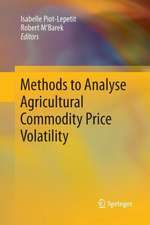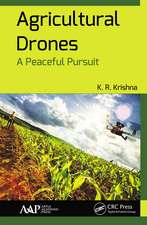Agroindustrial Waste for Green Fuel Application: Clean Energy Production Technologies
Editat de Neha Srivastava, Bhawna Verma, P. K. Mishraen Limba Engleză Hardback – 2 ian 2023
It is a useful guide for academician and environmentalist who are working to explore feasible advantages associated with these kinds of waste management and their effective valorization. It is also a great resource for senior undergraduate and graduate students, researchers, professionals, and other interested individuals/groups working in the field of biofuel/bioenergy.
| Toate formatele și edițiile | Preț | Express |
|---|---|---|
| Paperback (1) | 1219.01 lei 6-8 săpt. | |
| Springer Nature Singapore – 3 ian 2024 | 1219.01 lei 6-8 săpt. | |
| Hardback (1) | 1224.99 lei 6-8 săpt. | |
| Springer Nature Singapore – 2 ian 2023 | 1224.99 lei 6-8 săpt. |
Din seria Clean Energy Production Technologies
- 18%
 Preț: 1380.47 lei
Preț: 1380.47 lei - 18%
 Preț: 1223.55 lei
Preț: 1223.55 lei - 18%
 Preț: 950.52 lei
Preț: 950.52 lei - 18%
 Preț: 1388.53 lei
Preț: 1388.53 lei - 18%
 Preț: 777.50 lei
Preț: 777.50 lei - 24%
 Preț: 1205.09 lei
Preț: 1205.09 lei - 18%
 Preț: 1377.64 lei
Preț: 1377.64 lei - 24%
 Preț: 932.40 lei
Preț: 932.40 lei - 18%
 Preț: 1118.62 lei
Preț: 1118.62 lei - 18%
 Preț: 1219.01 lei
Preț: 1219.01 lei - 18%
 Preț: 1219.46 lei
Preț: 1219.46 lei - 18%
 Preț: 1219.63 lei
Preț: 1219.63 lei - 24%
 Preț: 785.78 lei
Preț: 785.78 lei - 18%
 Preț: 1552.36 lei
Preț: 1552.36 lei - 18%
 Preț: 1549.04 lei
Preț: 1549.04 lei - 18%
 Preț: 1216.65 lei
Preț: 1216.65 lei - 18%
 Preț: 947.35 lei
Preț: 947.35 lei - 18%
 Preț: 1222.01 lei
Preț: 1222.01 lei - 18%
 Preț: 1386.62 lei
Preț: 1386.62 lei - 18%
 Preț: 1216.95 lei
Preț: 1216.95 lei - 18%
 Preț: 1217.10 lei
Preț: 1217.10 lei - 18%
 Preț: 966.90 lei
Preț: 966.90 lei - 18%
 Preț: 1227.04 lei
Preț: 1227.04 lei - 24%
 Preț: 1146.26 lei
Preț: 1146.26 lei - 18%
 Preț: 1221.83 lei
Preț: 1221.83 lei
Preț: 1224.99 lei
Preț vechi: 1493.90 lei
-18% Nou
Puncte Express: 1837
Preț estimativ în valută:
234.39€ • 244.75$ • 193.56£
234.39€ • 244.75$ • 193.56£
Carte tipărită la comandă
Livrare economică 15-29 aprilie
Preluare comenzi: 021 569.72.76
Specificații
ISBN-13: 9789811962295
ISBN-10: 9811962294
Pagini: 326
Ilustrații: XIII, 326 p. 1 illus.
Dimensiuni: 155 x 235 mm
Greutate: 0.65 kg
Ediția:1st ed. 2023
Editura: Springer Nature Singapore
Colecția Springer
Seria Clean Energy Production Technologies
Locul publicării:Singapore, Singapore
ISBN-10: 9811962294
Pagini: 326
Ilustrații: XIII, 326 p. 1 illus.
Dimensiuni: 155 x 235 mm
Greutate: 0.65 kg
Ediția:1st ed. 2023
Editura: Springer Nature Singapore
Colecția Springer
Seria Clean Energy Production Technologies
Locul publicării:Singapore, Singapore
Cuprins
Chapter 1. Pulses waste to biofuels.- Chapter 2. Utilization of Wheat and Maize waste as Biofuel source.- Chapter 3. Agricultural residues and manures into bioenergy.- Chapter 4. Bioenergy from cellulose of Woody Biomass.- Chapter 5. Potential Technologies for Advanced Generation Biofuels from Waste Biomass.- Chapter 6. Biological pretreatment strategies for second generation lignocellulosic biomass to enhance ethanol production.- Chapter 7. Agricultural lignocellulosic waste to Biofuels.- Chapter 8. Mixed lignocellulosic feedstocks: An effective approach for enhanced biofuel production.- Chapter 9. Bioenergy: Challenges ahead and Future.- Chapter 10. Production of bioethanol from mixed lignocellulosic biomass:Future prospects and challenges.
Notă biografică
Dr. Neha Srivastava
DST-Woman Scientist-B
Department of Chemical Engineering and Technology, IIT (BHU) Varanasi-221005, U.P., India
Dr. Bhawna Verma
Department of Chemical Engineering and Technology, IIT (BHU) Varanasi-221005, U.P., India
Department of Chemical Engineering and Technology, IIT (BHU) Varanasi-221005, U.P., India
Textul de pe ultima copertă
The book revisit in depth scope of agroindustrial waste for enhancement in biofuels production on practical ground. It explores and discusses various cellulose rich agro-wastes along with low cost, advance technology based options for sustainable biofuels production. Lignocellulosic biomasses are potential producer of biofuels due to renewable nature and huge occurrence. Cellulose is the main polymeric component of these biomasses apart from lignin and hemicellulose. It can be converted into fermentable sugars using cellulase enzyme which can be further converted into the renewable energy sources such as biohydrogen, bioethanol, biogas and butanol. Chapters in this title provide exclusive and critical analysis of specific biofuels production process only from lignocellulosic biomass, based on their type, property, availability, cost and most important sugar or cellulose content along with the simplest process search for converting these biomasses into biofuels to make overall process more simple and economical.
It is a useful guide for academician and environmentalist who are working to explore feasible advantages associated with these kinds of waste management and their effective valorization. It is also a great resource for senior undergraduate and graduate students, researchers, professionals, and other interested individuals/groups working in the field of biofuel/bioenergy.
Caracteristici
Covers information about lignocellulosic biomass for biofuels application Provides detailed structuralexplanation to improve biofuels production Presents sustainable solution for practical application of biofuels


























